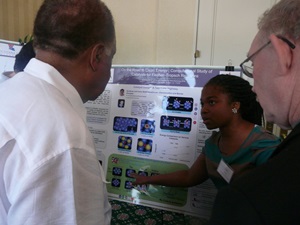NEWS
Louisiana Tech student, faculty-led groups place at state research competition
800×600
Normal
0
false
false
false
EN-US
X-NONE
X-NONE
MicrosoftInternetExplorer4
/* Style Definitions */
table.MsoNormalTable
{mso-style-name:”Table Normal”;
mso-tstyle-rowband-size:0;
mso-tstyle-colband-size:0;
mso-style-noshow:yes;
mso-style-priority:99;
mso-style-parent:””;
mso-padding-alt:0in 5.4pt 0in 5.4pt;
mso-para-margin:0in;
mso-para-margin-bottom:.0001pt;
mso-pagination:widow-orphan;
font-size:10.0pt;
font-family:”Times New Roman”,”serif”;}
Two Louisiana Tech University student and faculty-led groups recently received recognition for outstanding research during an annual research symposium held in Baton Rouge by the Louisiana Board of Regents.
The symposium officially marked the end of the 2013 “Research Experiences for Undergraduates” and “Research Experiences for Teachers” statewide summer programs offered by the Louisiana Alliance for Simulation-Guided Materials Applications (LA-SiGMA).

Tosin Oyeleke (center), a student in the 2013 Research Experiences for Undergraduates summer program, presents her research at the symposium.
Dr. Daniela Mainardi, associate professor and program chair of chemical engineering at Louisiana Tech, mentored a group that won second place with their project titled, “On the Road for Clean Energy: Computational Study of Catalysts for Fischer-Tropsch Reactions.” The group included Louisiana Tech graduate students Fernando Soto, Suraj Gwayali, and Purnima Kharidehal, along with visiting undergraduate student Tosin Oyeleke from the University of Maryland Baltimore County, and Aleta Overby, a teacher from Simsboro High School.
“In simple terms, we use computers to manipulate the next generation of materials that will solve one of the biggest challenges of this century: making energy available when and where it is needed,” said Soto. “This research contributes to the creation of sophisticated tools and materials that, up to recently, was only seen in science-fiction movies.”
Trenton Ford, a Baton Rouge Community College student who worked on the Louisiana Tech campus to conduct research this summer, also placed at the competition. His project titled, “Characterization of Alumina Supported Syn-gas Conversion Bimetallic Nanocatalysts,” tied for third place in the undergraduate division. Ford was mentored by Dr. Upali Siriwardane, professor of chemistry at Louisiana Tech, and Dr. Naidu Seetala of Grambling State University.
“My lab exposed me to more chemistry than ever before, and this program has further solidified my decision to go into a research field,” Ford said. “Research isn’t boring!”
LA-SiGMA researchers address the energy challenge by targeting a wide range of applications, batteries, catalysts and fuel cells, and by learning from teachers, scientists and engineers throughout the state.
“The LA-SiGMA summer programs have proved to be outstanding opportunities for us to involve middle and high school students, college students from two-year and four-year colleges, and also middle and high school teachers in cutting edge scientific research,” said Dr. Ramu Ramachandran, executive associate dean for research at Louisiana Tech and a Co-PI for LA-SiGMA. “It is terrific that the summer research done by these students in collaboration with LA-SiGMA researchers at Louisiana Tech is receiving this kind of recognition.”
The winners of the symposium competitions will have the opportunity to participate in the National Symposium of the Experimental Program to Stimulate Competitive Research (EPSCoR) organized by the National Science Foundation. The 2013 national symposium will be held in Nashville, Tenn. in November.
The LA-SiGMA Alliance includes Louisiana Tech, Louisiana State University, Tulane University, University of New Orleans, Southern University, Xavier University and Grambling State University, and is funded by a $20 million grant from the National Science Foundation.
Written by Alicia Boudreaux – aliciab@latech.edu
Recent Comments